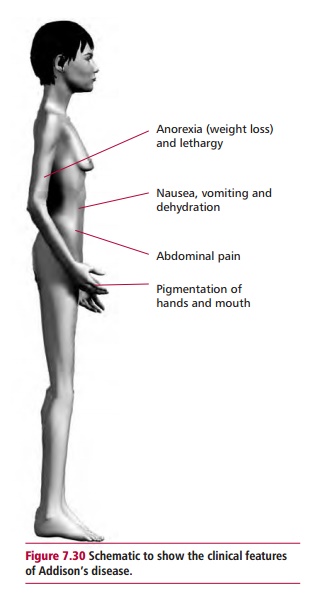Chapter: Biology of Disease: Disorders of the Endocrine System
Diagnosis and treatment of AddisonŌĆÖs disease
Diagnosis and treatment of AddisonŌĆÖs disease
A clinical suspicion of AddisonŌĆÖs disease can be confirmed by demonstrating hyperkalemia with hyponatremia . The plasma cortisol is usually, but not always, low in these patients. A high concentration of ACTH coupled with a low concentration of cortisol is indicative of AddisonŌĆÖs disease whereas low cortisol and ACTH values are suggestive of secondary adrenal insufficiency. The situation can be resolved using complex biochemical tests with the analog of ACTH, synacthen. The short synacthen test involves an intramuscular injection of 0.25 mg of synacthen. The concentration of plasma cortisol is measured within 30 min. If it rises by at least 200 or to a value greater than 550 nmol dmŌĆō3, then AddisonŌĆÖs disease is unlikely. If this is not the case, then it is appropriate to proceed to the long synacthen test which involves an intramuscular injection of 1 mg of ACTH daily for three days. On the fourth day, the short synacthen test is performed and the serum concentration of cortisol is measured. If this is less than 200 nmol dmŌĆō3 with no increase following administration of synacthen there is primary adrenal failure and the patient is suffering from AddisonŌĆÖs disease. If, however, there is an incremental increase of at least 200 nmol dmŌĆō3 above the baseline, then the decreased output of cortisol from adrenal gland is secondary and due to a deficiency of ACTH caused by a hypothalamic or pituitary disorder. Once AddisonŌĆÖs disease is diagnosed, it is necessary to ascertain its cause. A number of laboratories test for the presence of antibodies against the adrenal glands to see if there is an autoimmune cause. A plain abdominal X-ray may be useful in that it can detect calcification of adrenal glands as a result of TB .

The conventional therapy for AddisonŌĆÖs disease involves treatment with steroids, such as hydrocortisone and fludrocortisone, which possess glucocorticoid and mineralocorticoid activities respectively. If a patient is left untreated he or she will eventually experience an adrenal crisis precipitated by stress, bacterial infection, trauma or surgery, which is a medical emergency. Typical clinical features of a crisis are abdominal pain, vomiting, hypotension together with hyponatremia, hypoglycemia and hyperkalemia. Its treatment involves administering saline infusions to correct the hypotension, fluid and salt losses and intravenous steroids to correct glucocorticoid and mineralocorticoid deficiencies. The precipitating factors, such as bacterial infections, require identification and appropriate treatment.
Related Topics